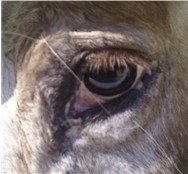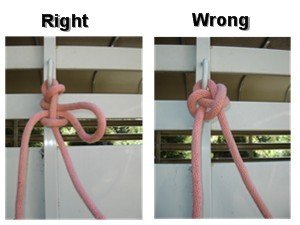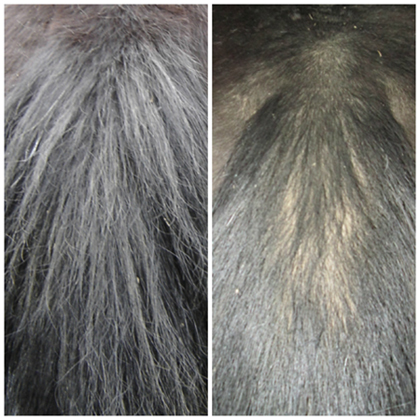Equine Eye Problems: Types and Fixes
Equine eye problems can be caused by injury, allergies, viruses and parasites. Eye problems can be tricky because there are so many causes; some mild and easy to treat, and some very serious. What makes it difficult is that the eye will show very similar symptoms for both mild and serious problems! Learn to tell the difference here.
Signs of Eye Problems in Horses

- Teary watery eyes(s)
- Gooey eye, green or yellow discharge
- Squinting
- Puffy, inflamed eye
- Red eye
- Horse rubs eye(s) frequently
- Cloudy eye
- Horse shows signs of pain or discomfort with eyes
- Sensitivity to light
- Dull eye
- Very crusty eye
Equine Eye Problems - Conjunctivitis
Conjunctivitis is inflammation of the tissues surrounding the eye and very commonly seen in horses. Equine conjunctivitis is often caused dust, flies and allergies, but can also be caused by; a foreign body, an eye injury, herpes virus and the Leptospriosis bacteria.
The first thing that you will notice with conjunctivitis is a watery discharge. If the eye is tearing alot it will run down the horses face. The dried secretions will be blackish and crusty. If the horse is exposed to very dusty conditions or flies, using a good mesh type fly mask will help protect your horse’s eyes.
If you have an otherwise healthy horse and suspect dust to be the cause, this can often be cleared up by flushing the eye 2-4 times a day with an equine eye wash. If the eye(s) don’t clear within a couple of days or worsen or you suspect something more serious, get your horse to the vet.
It is common for a horse with a mild case of conjunctivitis to develop a secondary bacterial infection in the eye. Your vet will need to flush the tear duct. They do this by inserting a very small long tube into the lachrymal duct, just inside the horse’s nostril, and then flushing it out with a large syringe containing a medicated/antibiotic wash.
Your vet may give a mild sedative if your horse requires it. They will also examine the eye to rule out any other factors like a foreign body, an injury or any disease. Usually one tear duct flush treatment is often all it takes to clear up a case of conjunctivitis. Your vet may also give you a tube of eye ointment to apply to the horse’s eye if they think it’s needed.
Equine Eye Problems – Recurrent Uveitis
If the eye problem is caused by equine recurrent uveitis, or you suspect it may be, take your horse to the vet immediately. Recurrent uveitis is the leading cause of blindness in horses. Fast aggressive treatment can save your horse’s vision, if you catch it in time. To learn more about it, see equine eye problems - recurrent uveitis for details.
Equine Eye Problems – Injury & Allergies & Herpes Virus

It’s a no brain’er when your horse has an obvious eye injury to take them to the vet, but what about something more subtle like a scratch? The first thing you may notice is a teary eye, or that your horse does not want to open the eye all the way. Without an eye examination it is difficult to tell if the eye has a small scratch that is irritating the eye or they have been infected with the Leptospriosis bacteria, the cause of recurring uveitis.
Just like people, horses can get watery eyes from environmental and food allergies. A simple teary eye is less likely to be as serious as an eye that is showing other symptoms of irritation like inflammation or green or yellowish ‘eye goo’. If in doubt consult your vet.
The equine herpes virus does not cause eye problems, but rather a discharge from the eyes is one of the symptoms of the herpes virus (rhinopneumonitis). Vaccinating horses and pregnant mares is the best prevention. See horse vaccines for more details.
Equine Eye Problems – Eye Worms
Eye worms are a parasite called Thelazia spp. Thelazia is common in Europe and Asia and has only been recently seen in North America. This parasite is more often found in cattle but can spread to horses and humans. It is passed from one animal to another via flies, another good reason to use a fly mask for your horse and practice good fly control measures.
If eye worms are found the vet physically removes them manually with forceps and an anesthetic for the animal. The eye is flushed with an iodine solution and antibiotics.
Good to Know
I highly recommend that you keep a bottle of 'Clear Eyes' Sterile eye-care solution for horses and ponies in your horse first aid kit. It's very good for treating dust and allergies. See what else to add to your horse care kit here.
Currently there is a worming combination that has proven effective for cattle, but not for horses. There are no treatments approved for use on horses in the United States.
Most horses will likely suffer a mild conjunctivitis at one time or another during the course of their lives. Luckily it is easily treated with no ill effects, but because the symptoms of conjunctivitis are so similar to more serious eye problems, it is important that you as a horse owner be aware, so you can make the best judgment call at to when to seek veterinary treatment.
More Equine Health Articles:
This information is written for the horseman to better understand and cope with the variety of disease and injury that can occur during the course of horse ownership. Always consult with your Veterinarian regarding the care and treatment of your equine.
Home > Horse Diseases > Equine Eye Problems


